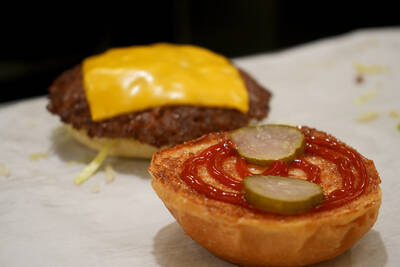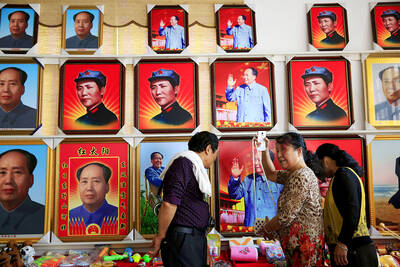Back in the day when reasonably priced Western restaurants were few and far between, Grandma Nitti’s was already providing comfort food for forlorn Westerners who had had enough of beef noodle soup and potstickers. Nitti’s location off Shida Road has become a well-known gathering place, and while the food on offer has drawn reviews ranging from the wildly enthusiastic to the derisive, the restaurant’s appeal has never faded for expats longing for a taste of home.
My Sweetie Pie Bakery & Cafe, located almost directly opposite, looks like it might have been transplanted from Taipei’s up-market East District (東區), but is in fact an extension of the Grandma Nitti operation. Clean lines, whitewashed walls and abundant natural light generate an air of casual sophistication.
My Sweetie shares some elements of Grandma Nitti’s menu, but according to Rainbow Lin (林虹惠), the driving force behind both operations, her new project is restricted to smaller brunch and snack dishes. The reason for this is to highlight the cake selection, which is displayed in a way that seems to wink alluringly at passersby.
Priced at around NT$90 a slice, the large portions of American-style cakes fill a niche in a market dominated by elaborately decorated production-line sweets or chichi concoctions of French or Japanese-inspired patisseries. Offerings such as carrot cake (NT$90) and warm chocolate cake (NT$80) make an appealing pairing with a large mug of coffee (hot NT$100; iced NT$110), and the banana chocolate cake (NT$90) is recommended for its robust textures and fresh banana flavor. This is comfort food, but there is an admirable restraint in the use of sugar and fat, and the cakes are nicely presented without being drowned in whipped cream.
For more savory palates, there are a number of brunch variations on offer, such as poached eggs with pesto sauce, ham and toast (NT$180), or light lunch meals that include homemade beef lasagna (with homemade pasta, NT$270). The prices include regular coffee or tea. A slice of cake or pie can be added to all orders for an additional NT$60, making for a very reasonably priced meal.
Apart from the restaurant service, My Sweetie Pie also sells cakes to order. Four-inch (10cm), 6-inch (15cm) and 8-inch (20cm) sizes are available, with prices for an 8-inch cake around NT$800.
The usual range of coffees, slushies, smoothies and milk shakes are available. My Sweetie serves also Mighty Leaf specialty teas as an added attraction.
The large airy space, open kitchen with gleaming surfaces, comfortable sofas and side tables with individual table lamps make this a location equally suited to work or relaxation. The friendly service and free Wi-Fi are icing on the cake.
— IAN BARTHOLOMEW

Taiwan can often feel woefully behind on global trends, from fashion to food, and influences can sometimes feel like the last on the metaphorical bandwagon. In the West, suddenly every burger is being smashed and honey has become “hot” and we’re all drinking orange wine. But it took a good while for a smash burger in Taipei to come across my radar. For the uninitiated, a smash burger is, well, a normal burger patty but smashed flat. Originally, I didn’t understand. Surely the best part of a burger is the thick patty with all the juiciness of the beef, the

The ultimate goal of the Chinese Communist Party (CCP) is the total and overwhelming domination of everything within the sphere of what it considers China and deems as theirs. All decision-making by the CCP must be understood through that lens. Any decision made is to entrench — or ideally expand that power. They are fiercely hostile to anything that weakens or compromises their control of “China.” By design, they will stop at nothing to ensure that there is no distinction between the CCP and the Chinese nation, people, culture, civilization, religion, economy, property, military or government — they are all subsidiary

Nov.10 to Nov.16 As he moved a large stone that had fallen from a truck near his field, 65-year-old Lin Yuan (林淵) felt a sudden urge. He fetched his tools and began to carve. The recently retired farmer had been feeling restless after a lifetime of hard labor in Yuchi Township (魚池), Nantou County. His first piece, Stone Fairy Maiden (石仙姑), completed in 1977, was reportedly a representation of his late wife. This version of how Lin began his late-life art career is recorded in Nantou County historian Teng Hsiang-yang’s (鄧相揚) 2009 biography of him. His expressive work eventually caught the attention

This year’s Miss Universe in Thailand has been marred by ugly drama, with allegations of an insult to a beauty queen’s intellect, a walkout by pageant contestants and a tearful tantrum by the host. More than 120 women from across the world have gathered in Thailand, vying to be crowned Miss Universe in a contest considered one of the “big four” of global beauty pageants. But the runup has been dominated by the off-stage antics of the coiffed contestants and their Thai hosts, escalating into a feminist firestorm drawing the attention of Mexico’s president. On Tuesday, Mexican delegate Fatima Bosch staged a